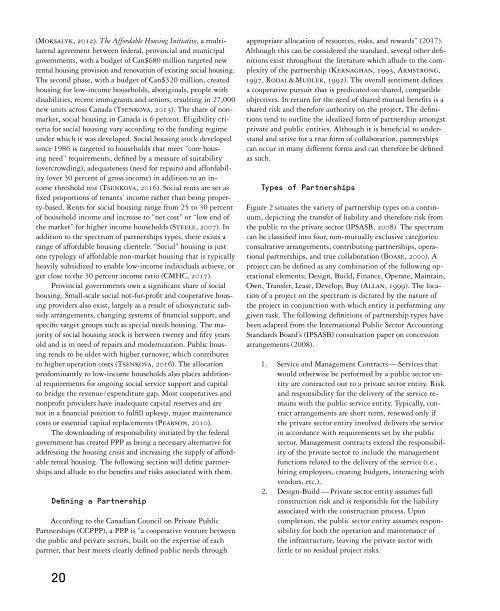The Vienna Model 2 – Housing for the City of the 21st Century
ISBN 978-3-86859-576-5 https://www.jovis.de/de/buecher/details/product/the-vienna-model-2.html
ISBN 978-3-86859-576-5
https://www.jovis.de/de/buecher/details/product/the-vienna-model-2.html
Create successful ePaper yourself
Turn your PDF publications into a flip-book with our unique Google optimized e-Paper software.
(Moksalyk, 2012). <strong>The</strong> Af<strong>for</strong>dable <strong>Housing</strong> Initiative, a multilateral<br />
agreement between federal, provincial and municipal<br />
governments, with a budget <strong>of</strong> Can$680 million targeted new<br />
ren tal housing provision and renovation <strong>of</strong> existing social housing.<br />
<strong>The</strong> second phase, with a budget <strong>of</strong> Can$320 million, created<br />
hous ing <strong>for</strong> low-income households, aboriginals, people with<br />
disabilities, recent immigrants and seniors, resulting in 27,000<br />
new units across Canada (Tsenkova, 2013). <strong>The</strong> share <strong>of</strong> nonmarket,<br />
social housing in Canada is 6 percent. Eligibility criteria<br />
<strong>for</strong> social housing vary according to <strong>the</strong> funding regime<br />
under which it was developed. Social housing stock developed<br />
since 1986 is targeted to households that meet “core housing<br />
need” requirements, defined by a measure <strong>of</strong> suitability<br />
(overcrowding), adequateness (need <strong>for</strong> repairs) and af<strong>for</strong>dability<br />
(over 30 percent <strong>of</strong> gross income) in addition to an income<br />
threshold test (Tsenkova, 2016). Social rents are set as<br />
fixed propor tions <strong>of</strong> tenants’ income ra<strong>the</strong>r than being property-based.<br />
Rents <strong>for</strong> social housing range from 25 to 30 percent<br />
<strong>of</strong> household income and increase to “net cost” or “low end <strong>of</strong><br />
<strong>the</strong> market” <strong>for</strong> higher income households (Steele, 2007). In<br />
addition to <strong>the</strong> spectrum <strong>of</strong> partnerships types, <strong>the</strong>re exists a<br />
range <strong>of</strong> af<strong>for</strong>dable housing clientele. “Social” housing is just<br />
one typology <strong>of</strong> af<strong>for</strong>dable non- market housing that is typically<br />
heavily subsidized to enable low-income individuals achieve, or<br />
get close to <strong>the</strong> 30 percent income ratio (CMHC, 2017).<br />
Provincial governments own a significant share <strong>of</strong> social<br />
housing. Small-scale social not-<strong>for</strong>-pr<strong>of</strong>it and cooperative housing<br />
providers also exist, largely as a result <strong>of</strong> idiosyncratic subsidy<br />
arrangements, changing systems <strong>of</strong> financial support, and<br />
specific target groups such as special needs housing. <strong>The</strong> majority<br />
<strong>of</strong> social housing stock is between twenty and fifty years<br />
old and is in need <strong>of</strong> repairs and modernization. Public housing<br />
tends to be older with higher turnover, which contributes<br />
to higher operation costs (Tsenkova, 2016). <strong>The</strong> allocation<br />
predominantly to low-income households also places additional<br />
requirements <strong>for</strong> ongoing social service support and capital<br />
to bridge <strong>the</strong> revenue / expenditure gap. Most cooperatives and<br />
nonpr<strong>of</strong>it providers have inadequate capital reserves and are<br />
not in a financial position to fulfill upkeep, major maintenance<br />
costs or essential capital replacements (Pearson, 2010).<br />
<strong>The</strong> downloading <strong>of</strong> responsibility initiated by <strong>the</strong> federal<br />
government has created PPP as being a necessary alternative <strong>for</strong><br />
addressing <strong>the</strong> housing crisis and increasing <strong>the</strong> supply <strong>of</strong> af<strong>for</strong>dable<br />
rental housing. <strong>The</strong> following section will define partnerships<br />
and allude to <strong>the</strong> benefits and risks associated with <strong>the</strong>m.<br />
Defining a Partnership<br />
According to <strong>the</strong> Canadian Council on Private Public<br />
Partnerships (CCPPP), a PPP is “a cooperative venture between<br />
<strong>the</strong> public and private sectors, built on <strong>the</strong> expertise <strong>of</strong> each<br />
partner, that best meets clearly defined public needs through<br />
appropriate allocation <strong>of</strong> resources, risks, and rewards” (2017).<br />
Although this can be considered <strong>the</strong> standard, several o<strong>the</strong>r definitions<br />
exist throughout <strong>the</strong> literature which allude to <strong>the</strong> complexity<br />
<strong>of</strong> <strong>the</strong> partnership (Kernaghan, 1993, Armstrong,<br />
1997, Rodal & Mudler, 1992). <strong>The</strong> overall sentiment defines<br />
a cooperative pursuit that is predicated on shared, compatible<br />
objectives. In return <strong>for</strong> <strong>the</strong> need <strong>of</strong> shared mutual benefits is a<br />
shared risk and <strong>the</strong>re<strong>for</strong>e authority on <strong>the</strong> project. <strong>The</strong> definitions<br />
tend to outline <strong>the</strong> idealized <strong>for</strong>m <strong>of</strong> partnership amongst<br />
private and public entities. Although it is beneficial to understand<br />
and strive <strong>for</strong> a true <strong>for</strong>m <strong>of</strong> collaboration, partnerships<br />
can occur in many different <strong>for</strong>ms and can <strong>the</strong>re<strong>for</strong>e be defined<br />
as such.<br />
Types <strong>of</strong> Partnerships<br />
Figure 2 situates <strong>the</strong> variety <strong>of</strong> partnership types on a continuum,<br />
depicting <strong>the</strong> transfer <strong>of</strong> liability and <strong>the</strong>re<strong>for</strong>e risk from<br />
<strong>the</strong> public to <strong>the</strong> private sector (IPSASB, 2008). <strong>The</strong> spectrum<br />
can be classified into four, non-mutually exclusive categories:<br />
consultative arrangements, contributing partnerships, operational<br />
partnerships, and true collaboration (Boase, 2000). A<br />
project can be defined as any combination <strong>of</strong> <strong>the</strong> following operational<br />
elements; Design, Build, Finance, Operate, Maintain,<br />
Own, Transfer, Lease, Develop, Buy (Allan, 1999). <strong>The</strong> location<br />
<strong>of</strong> a project on <strong>the</strong> spectrum is dictated by <strong>the</strong> nature <strong>of</strong><br />
<strong>the</strong> project in conjunction with which entity is per<strong>for</strong>ming any<br />
given task. <strong>The</strong> following definitions <strong>of</strong> partnership types have<br />
been adapted from <strong>the</strong> International Public Sector Accounting<br />
Standards Board’s (IPSASB) consultation paper on concession<br />
arrangements (2008).<br />
1. Service and Management Contracts — Services that<br />
would o<strong>the</strong>rwise be per<strong>for</strong>med by a public sector entity<br />
are contracted out to a private sector entity. Risk<br />
and responsibility <strong>for</strong> <strong>the</strong> delivery <strong>of</strong> <strong>the</strong> service remains<br />
with <strong>the</strong> public service entity. Typically, contract<br />
arrangements are short term, renewed only if<br />
<strong>the</strong> private sector entity involved delivers <strong>the</strong> service<br />
in accordance with requirements set by <strong>the</strong> public<br />
sector. Management contracts extend <strong>the</strong> responsibility<br />
<strong>of</strong> <strong>the</strong> private sector to include <strong>the</strong> management<br />
functions related to <strong>the</strong> delivery <strong>of</strong> <strong>the</strong> service (i.e.,<br />
hiring employees, creating budgets, interacting with<br />
vendors, etc.).<br />
2. Design-Build — Private sector entity assumes full<br />
con struction risk and is responsible <strong>for</strong> <strong>the</strong> liability<br />
associated with <strong>the</strong> construction process. Upon<br />
completion, <strong>the</strong> public sector entity assumes responsibility<br />
<strong>for</strong> both <strong>the</strong> operation and maintenance <strong>of</strong><br />
<strong>the</strong> infrastructure, leaving <strong>the</strong> private sector with<br />
little to no residual project risks.<br />
20


















